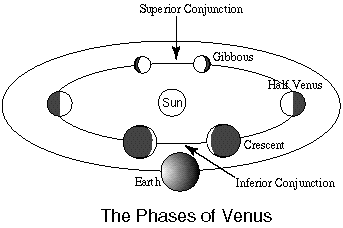
Observing Venus
Venus is by far the brightest star-like object in the sky and on its major appearences, observatories get an extra number of calls reporting UFO's. People who have not noticed it before cannot believe that it is so bright.
The orbit of Venus is inside that of the Earth, so it never gets more than about four hours away from the sun, and never appears in the midnight sky. Venus appears as a morning or evening star, although it does get far enough from the Sun to shine brilliantly in the dark sky.
As you see from the diagram below, Venus goes through phases like the Moon.

When Venus is in crescent phase, it is closer to the Earth and larger. In the gibbous phase, Venus is further away and smaller. Galileo sited this phenomena as evidence that Venus really goes around the Sun, and not the Earth. The phases are easily visible in a small telescope, especially the crescent phase. Venus is so bright, that it sometimes helps to look for the phases through your telescope in the dusk, when the twilight sky mutes its brightness. With care, you can see the crescent phase even in binoculars.
Venus can sometimes be seen in broad daylight with the Sun in the sky if you know exactly where to look. When you look right at it, it is visible, but if you look away, it gets lost in the endless blue. Ways to locate it in the daytime are:
1. Watch it as a morning star at dawn, continually noting its location as the Sun rises.
2. Use a telescope with coordinates to find it, and look along the telescope.
3. Find a time when the moon is in conjunction with Venus, and use the moon to locate it.
The more interesting configurations start to occur towards summer 1999. Venus reaches greatest eastern elongation (highest in the evening sky) on June 11, 1999; on that date it is half-Venus phase. It quickly passes through the waning crescent phase as the planet catches up with the Earth at inferior conjunction on Aug 20, 1999. Then it jumps into the morning sky, racing through the waxing crescent phases to half-Venus phase again at greatest western elongation on Oct. 30, 1999.
Back to Observational Page